Fishing Steelhead: FULL ARTICLE
Clear Water Steelhead Fishing
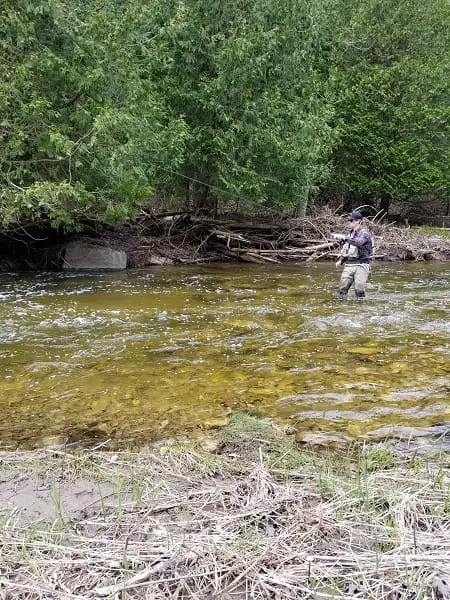
Four or five days after big rains and high water especially if no further rains occur, there will be fewer steelhead in the lower river as they move further up the rivers and start to spread out.
This is when it’s best to pick areas of rivers where you can wander and search for steelhead in many pools.
If it hasn’t rained for a week or more the rivers can become very low and very clear and this slows steelhead migrations.
Clear water streams can be difficult to fish since steelhead can detect anglers walking around the waterway. Steelhead’s eyesight is incredible during these periods, as is their ability to pick up vibrations from stumbling and heavy-footed anglers.
During these low water conditions, it’s always best to fish for steelhead in the bigger or deepest pools or in sections with structure like log jams where they will concentrate and wait for higher water before they start moving again.
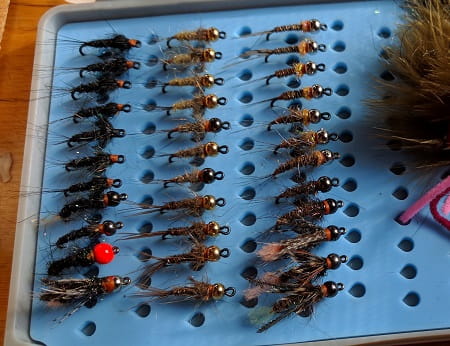
In low clear water, small baits like single eggs, beads, flies, worms, and small spawn bags are most productive.
Smaller nymph flies are often my most effective bait when the steelhead are nervous or pressured in low clear water.
You may also find that during these super low water conditions and when no rains have occurred for a long time, there can be a lot of steelhead staging at the river mouths, and this can be the hot spot.
These are the next runs of steelhead and while guys are up the river looking for steelhead that are spread out, other guys are smashing them in the lower river.
Reading Steelhead Rivers
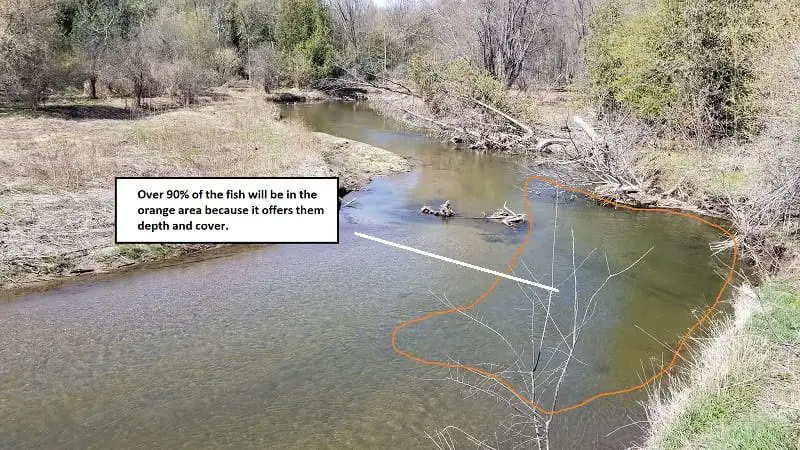
Reading the river is a skill that will enable you to find and catch more fish.
Most steelhead streams are similar with the same characteristic which include typical shallow riffles and rapids between the pools. corner pool, dams, large rocks, and even waterfalls make it easy to figure out where the steelhead will be holding.
These types of rivers are easy rivers to read and easier to determine where the steelhead will be.
Some rivers are not so easy to read. Flat water rivers, slow water, deep water, and huge rivers that are almost lake-like can be very difficult to read.
On a huge river with unreadable water, anglers will use sonar units to find the structure and the holding spots, or they will look for current seams and visible structures. The tributaries to these large rivers will often be much easy to read and find fish.
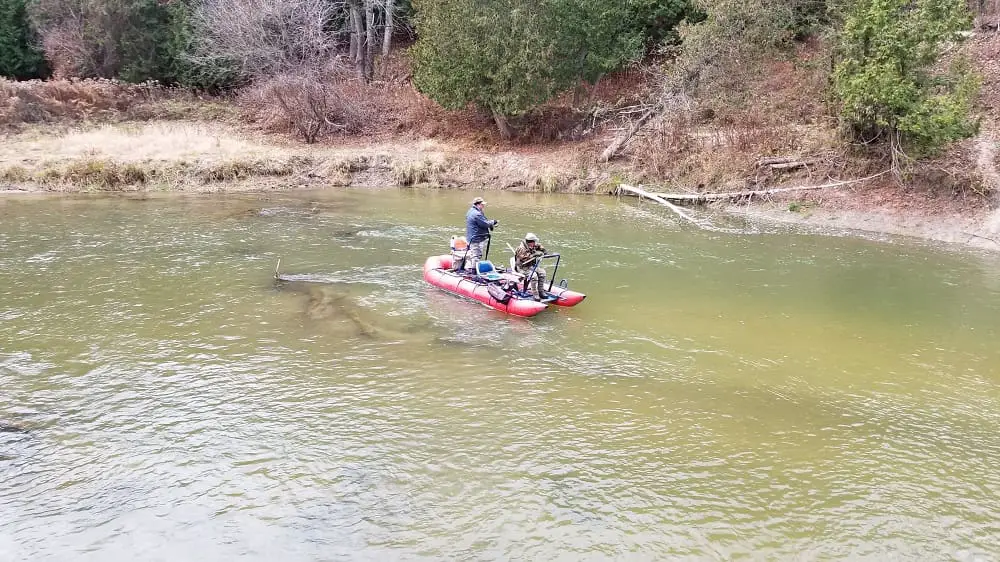
Steelhead will generally look for deeper water whenever possible and unless they are spawning they won’t stay in shallow water under 2 feet deep for long.
Deeper riffles and rapids 3 feet deep or more can be good spots. Deeper pockets in front or behind rocks can also be good especially if the fish are working their way up the river.
Pools are the easiest water to read and are often where the most fish will be. Or at least the most feeding fish.
The steelhead will often move quickly up through the shallow rapids and then rest in the pools before they traverse the next set of riffles and rapids.
When fishing the pools, look for feeding lanes, or bubble lines. and current seams. These areas concentrate food and steelhead and allow them to get out of the fastest water.
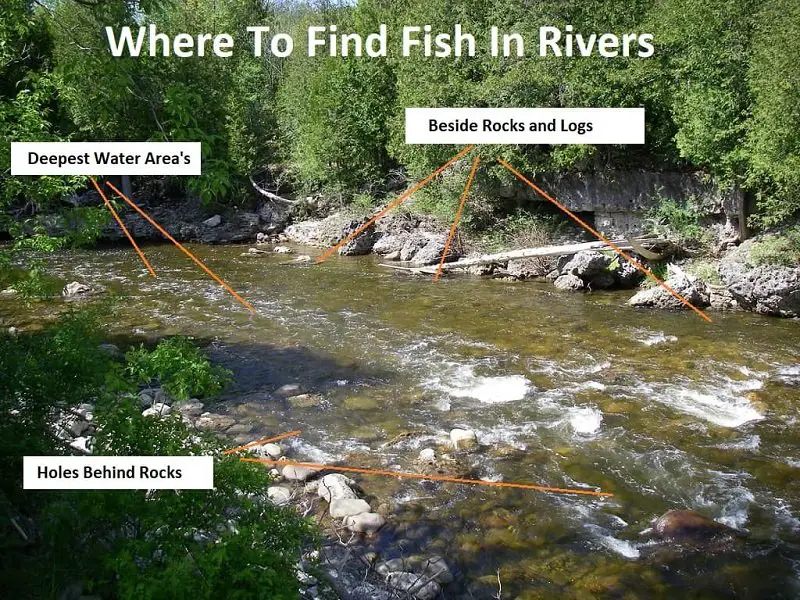
In the coldest months of January and February, the steelhead will be in the deepest part of the pool, or the slowest part of the pool.
This is often in the middle of the pool or near the tail of the pool, which is often called the tail-out.
During the spring and fall runs, the steelhead will move from the tail-out section and closer to the top of the pool known as the head of the pool. They will often rest for a short time at the head of the pool before moving up and into the next riffle.
Fishing Steelhead Through The Seasons
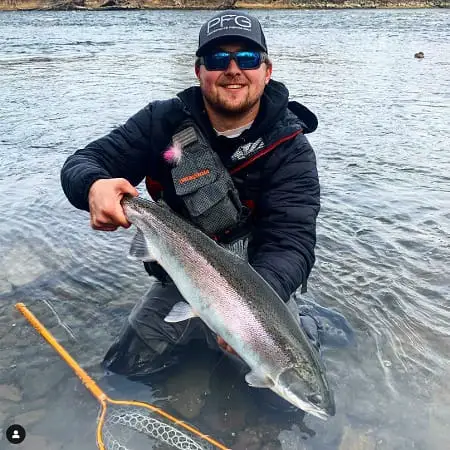
Most anglers understand that the best steelhead fishing means the spring steelhead runs that are triggered by rains and snow melting, resulting in high waters, but that’s not the only time the steelhead will enter or be in the rivers.
In fact, steelhead can enter fresh water rivers 12 months of the year.
Fall and winter can also be fantastic times to be steelhead fishing and in some areas, the summer fishing can be good with steelhead summer runs.
Spring Steelhead Fishing
It’s not only water levels that trigger steelhead runs in the spring or fall.
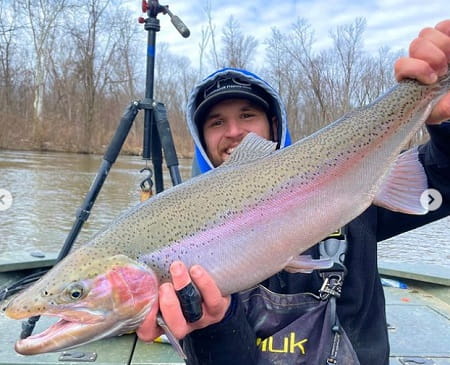
The time of year can also be a trigger. In some cases, the steelhead won’t have ideal conditions like big rains to trigger the runs, but as their biological clock ticks in the spring and the steelhead can’t wait any longer, the urgency to get up the river to spawn can make the steelhead run even under super low water conditions and bad temperatures.
The urgency to enter the rivers can also be there in the fall, and for some steelhead on some rivers, that urgency will hit them in the summer and winter too.
When unsuitable river conditions last for too long, and the spawning urgency takes over, I have seen small runs of steelhead enter very low rivers during the low light hours and through the night.
These runs are nearly impossible to predict. Steelhead fishing during these times can be tough.
However, most steelhead enter the rivers in the spring just as the ice melts and the river temperatures start to warm. Unlike summer, fall, and winter-run steelhead, spring steelhead are close to reproductive maturity and will spawn soon after entering the river.
There are three stages to the spring steelhead run, and I fish each stage differently to ensure the most fish. Unfortunately, most anglers don’t understand this, and they fish the same spots and same baits, and the same methods, and then they struggle to catch steelhead.
I discuss spring steelhead fishing in detail on my page Spring Steelhead Fishing: Tips And Tactics From The Guides.
Fall Steelhead Fishing
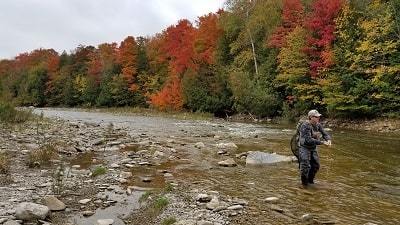
Fall steelhead fishing is my favorite time and I know it is for many other guides and anglers.
The reason for this is more stable river conditions, predictable runs, and after spending the summer in the lake or ocean getting big and strong, fall steelhead tend to be aggressive, feed readily, and fish the hardest.
The only downside to the fall is steadily dropping water and air temperatures that can change the steelhead feeding behaviors, and their holding locations.
Understanding how to fish during these changing times can put a lot more steelhead in your net. To find out more, see Fall Steelhead Fishing: Proven Guide Tips And Tactics.
Fall steelhead fishing can be particularly interesting since you may end up catching huge migratory brown trout or huge salmon which are also in the river in good numbers in October. Both of these fish species can be in the same spots and caught using the same methods.
Fall/Winter steelhead will often start showing up in October and peak in November and December.
In the fall, most or all summer steelhead will already be in the river and late fall or winter steelhead will continue to enter the rivers which means there is usually plenty of fish in the river.
Winter Steelhead Fishing
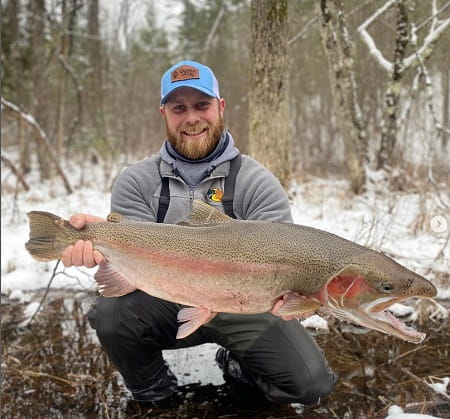
Steelhead fishing in the winter is tough for most anglers, but many steelhead will have entered the river in late fall and sporadic winter runs will continue throughout the winter, so there is usually plenty of steelhead around.
Winter steelhead fishing is when my clients and I have had days with the highest number of steelhead caught.
Some winter days, over 40 large steelhead a day will hit my net and not a single angler is anywhere in sight. Even in the coldest month of January, on warm days the steelhead fishing can be excellent.
Winter fishing means few anglers and possible solitude, with some scattered winter runs of steelhead if the conditions are suitable, combined with holdover summer and fall steelhead that just sitting and waiting for springlike temps to start spawning.
For many, Winter steelhead fishing can also mean very tough to catch steelhead if you don’t know what you are doing.
During the winter, winter steelhead feed differently, the effective baits from the fall might be different now, and the winter steelhead holding locations can also be different than at other times of the year.
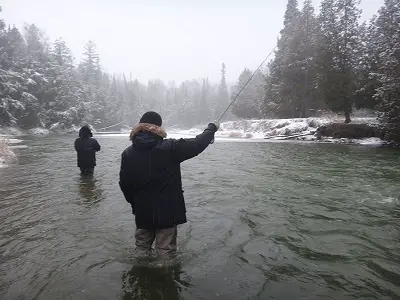
The problem for most anglers is twofold. Anglers simply do not understand how to fish winter steelhead, and they don’t know how to stay warm and comfortable.
Winter steelhead fishing requires anglers to fish slower and deeper, and to find areas that winter steelhead will hold. You may also need to fish smaller baits and lures since winter steelhead will be less aggressive.
Winter steelhead anglers will also need to pick their fishing times more carefully and fish select days when the weather, water temps, and air temps are more suitable for feeding fish.
Water temperatures play a huge part of fish feeding behavior and anglers that understand this will catch a lot more fish. This means determining the time of day when the water is warmest, and choosing warmer days to fish.
I discuss this in detail on my page Winter Steelhead Fishing Tactics and Tips From Guides.
Summer Steelhead Fishing
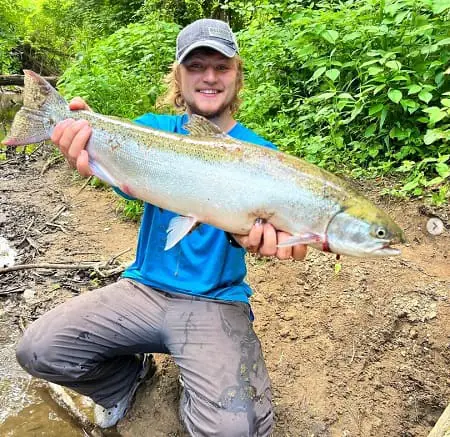
In some areas, summer steelhead fishing in the rivers is possible due to natural summer run steelhead and a special summer steelhead fish species known as a Skamania.
On the west coast summer run steelhead can be fantastic with summer steelhead entering the rivers starting in July, through August, and into the fall.
Late August to mid September are peak times, with most summer steelhead in the rivers by late October or November.
Summer run steelhead will reach reproductive maturity months after they enter the rivers. This means summer steelhead are accessible to anglers sometimes over 6 months before they spawn and leave the river.
Only some states stock the hard-fighting summer-run steelhead and the Skamania and they are only stocked on some rivers. This provides some interesting angling opportunities for some lucky steelhead anglers.
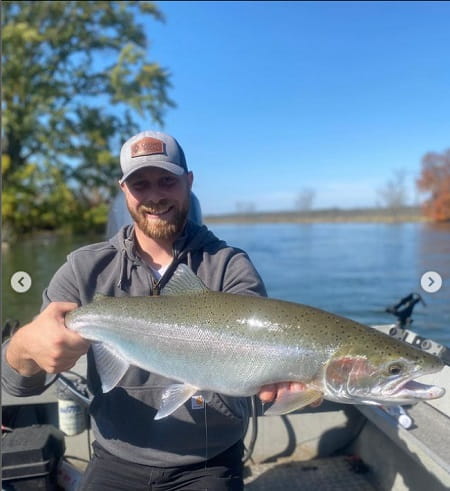
Since summer steelhead hold in the river for months, they need to eat. Since they are often in the river when the salmon are spawning, salmon eggs and nymphs can be great baits.
Casting spinners and spoons and crankbaits are also very effective.
Although they are a summer run steelhead, summer steelhead will spawn in late winter and early spring and often leave the river around March.
On some rivers, you will find summer steelhead mixed in with rainbow trout and other trout species while they wait for good spawning conditions.
For more, check out Summer Steelhead Fishing
Steelhead Fishing Methods: How To Catch Steelhead
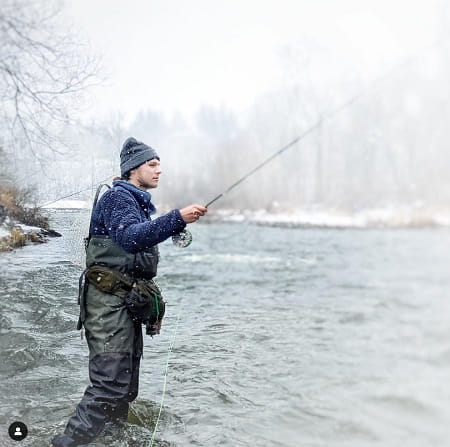
There are four primary methods used to catch steelhead in rivers. These methods are the most effective for steelhead fishing, and I will discuss them and a few others in more detail below.
- Float fishing
- Drift fishing
- Fly fishing
- Lure Fishing
Float Fishing For Steelhead In Rivers
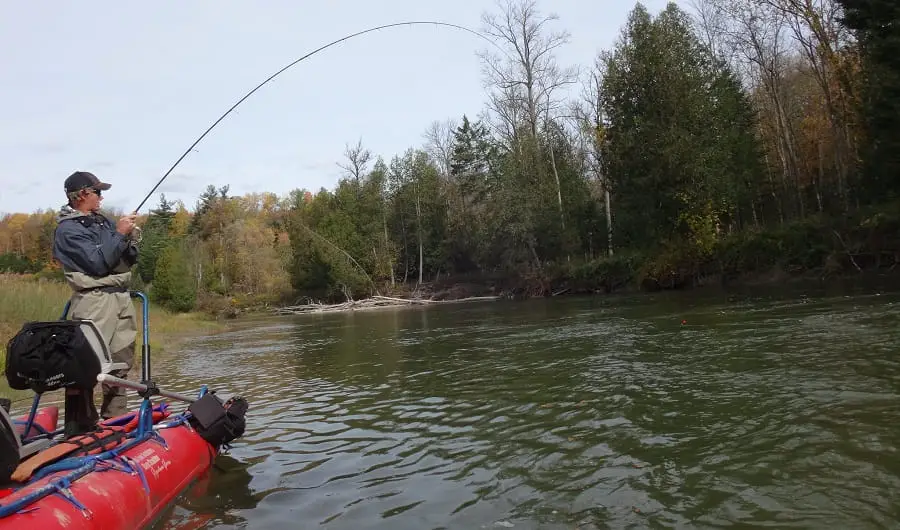
One of the most effective methods for steelhead fishing is to float fish.
Float fishing for steelhead simply means you are presenting a bait below a bobber which is more commonly called a float by river anglers. You drift your float and your bait down the river to the fish in the most natural way possible.
The float suspends your bait and weight just off the bottom and keeps it in the strike zone longer.
Float fishing can be very effective in any water that is over 3 feet deep and under 15 feet deep. However, the use of slip float can allow anglers to fish deeper if needed.
Float fishing can be done using spinning reels and long rods, Centerpin reels and rods, or even with baitcasting reels. Depending on what part of the country you are in different methods might be more popular.
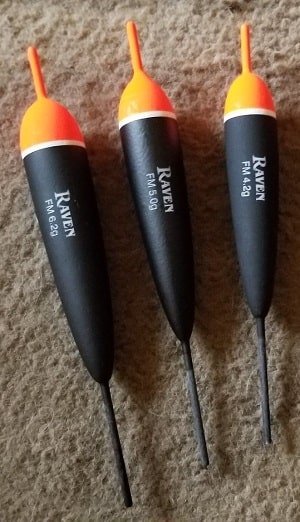
Many anglers like to use spinning reels for float fishing. I discuss the best methods for float fishing on my page Float Fishing For Steelhead – A River Guides Advice.
Float fishing requires the use of baits and the most common bait is the spawn sac or roe bag. I use a lot of baits and will rotate baits to find the best one based on the conditions or what the fish want, so it’s smart to have a few options in your vest or pack.
I also found that some baits work better at certain times of the year. I discuss the top baits on my page 11 Best Steelhead Baits, however, I have recently updated that page and it now has 7 of my best baits and link to more great baits.
Spin Fishing For Steelhead In Rivers
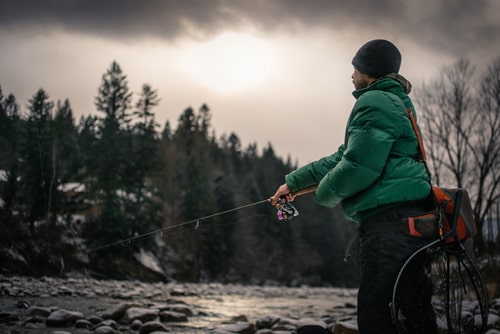
Spinning rod fishing is popular everywhere that guys fish for steelhead. With a spinning reel and a spinning rod you can float fish, bottom bounce, cast lures, troll, and even still fish.
Spinning reels are also used when trolling and drift fishing from a riverboat.
When spin fishing for steelhead you want to get a reel that has a good smooth drag system that can handle fast pulling fish like steelhead, good bearings are also important and a spool that can hold a lot of line.
I discuss the best spinning reels for float fishing and for lure fishing or just general steelhead fishing on my page Best Spinning Reels.
I also like long rods from 8 to 10 feet for casting lures, and I prefer rods from 11 to 14 feet for float fishing. A good rod for both casting lures and for float fishing would be between 9 and 11 feet. Check out Best River Fishing Rods Of 2021: Trout And Steelhead Rods.
I also tell you what the best lines are for steelhead fishing on my page about float fishing lines.
Check my page on Spin Fishing For Steelhead for full details, my tactics, and tips for catching more steelhead with spinning reels.
Although spinning reels can be used for float fishing, if you are new to float fishing and are just getting set up, I recommend float fishing with Centerpin reels instead.
Centerpin Fishing For Steelhead In Rivers
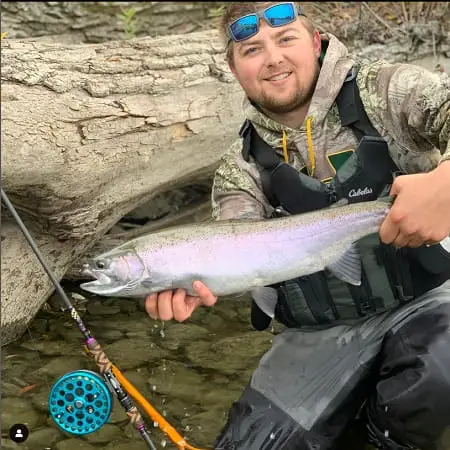
I have been Centerpin fishing for over 30 years and I have been guiding and teaching anglers how to Centerpin fish for steelhead for about 20 years and I can honestly say that in most rivers Centerpin fishing is by far the best method for catching steelhead in rivers.
Centerpin fishing is simply using a large round reel that looks like a fly reel, but it holds the mono or braided line and it has no drag. The Centerpin reel free spools and it’s designed to drift a float with a bait down the river. The free spool of the reel and the smoothness of the reel allow for the best possible presentation of the bait.
The Centerpin reel is combined with long rods which help with presentation and help to fight and land big fish.
This method is deadly on steelhead, salmon, and even trout in rivers if it is done right. I discuss the setup, the leaders, the baits and how to present the bait, and more on my page Centerpin Fishing For Beginners: 20 Steps From A Top Guide. Basically, everything you need to know to be a great Centerpin angler can be found on that page.
If you are a river angler that wants to catch more steelhead, then I highly recommend you learn about this method.
Fly Fishing For Steelhead
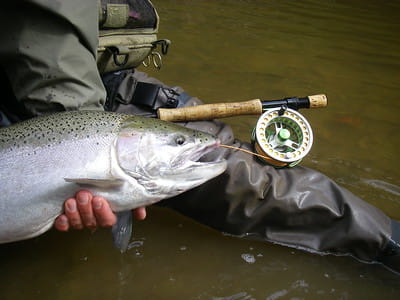
Fly fishing for steelhead is my preferred method for fishing for steelhead because I find it more challenging than some of the other methods and because it’s fun.
If done right, fly fishing for steelhead can be very effective and in some river situations, it can be more effective than bait and float fishing.
Fly fishing for steelhead can be done using four different methods of fly fishing which include Nymph Fishing, Streamer fishing, Spey fishing, and even Euro Nymphing.
I discuss each of these fly fishing methods and how to do them as well as the best setup, leaders, flies, and more on my page Fly Fishing For Steelhead: Great Lakes Style.
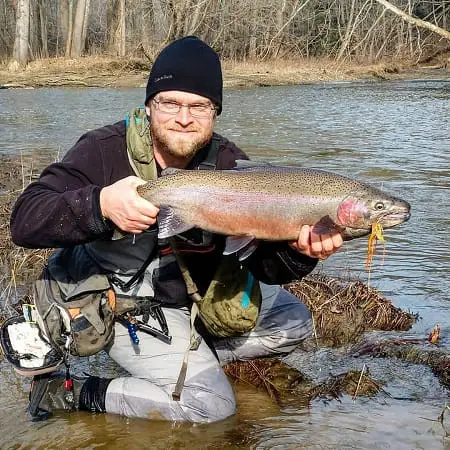
Fly fishing for steelhead is often most effective in river sections from 2 to 8 feet deep and excels in shallower water.
Fly fishing is also great when fishing steelhead creeks or smaller tributaries.
Many guides like Gareth from Alley Grabs Guide Service and I like to Spey fish the bigger rivers.
Spey fishing allows us to cover more water faster and the hit from a big aggressive steelhead is hard to beat.
With fly fishing, the flies can imitate salmon eggs, nymphs, and baitfish. Drifting a combo nymph and eggs setup is hard to beat anywhere steelhead exists.
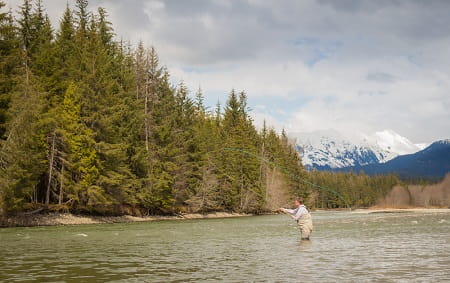
In some areas, it’s hard to find a river guide that doesn’t just do fly fishing which shows how well this method works.
With fly fishing, a rod of 9 to 11 feet is used with a 10-foot fly rod in the 7 to 8 weight range being the best rod size.
If fly fishing is something you think you might be interested in, you won’t find another resource that will provide you with as much information, tips, and proven tactics on fly fishing for steelhead as you will find in my series on fly fishing for steelhead, starting with that page.
Drift Fishing For Steelhead
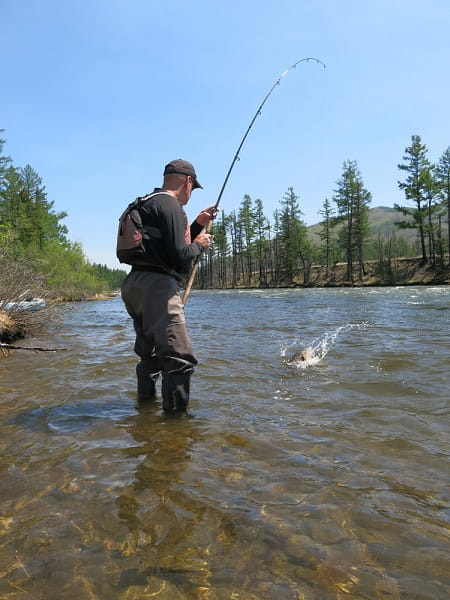
Drift Fishing for steelhead is primarily done from the river bank or while wading but some forms can also be done from a boat.
With drift fishing, you have weights on the line and a leader, and a bait or two. You only use just enough weights to get your bait down and ticking along the bottom.
The advantage of drift fishing is it works well in deeper water depths from 5 to 30 feet deep and in medium to fast currents.
The tricky part is that for new anglers it can be difficult to detect a bite or to tell the difference between a bite and the bottom.
Most anglers will use a spinning reel or a baitcasting reel when drift fishing.
I discuss steelhead drift fishing in detail and show you guide leader setups and best baits on my page Drift Fishing For Steelhead: A Complete Guide.
Bottom Bouncing For Steelhead In Rivers
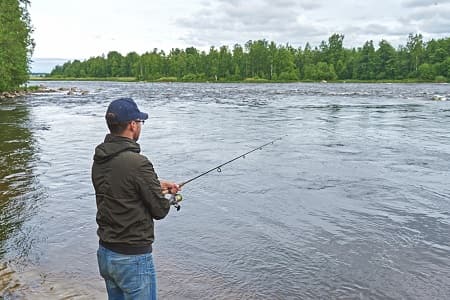
Bottom bouncing is an old-school method that anglers used to use when steelhead fishing and some anglers still use it today.
It has been overshadowed by the float fishing anglers that seem to catch more fish.
However, bottom bouncing can be the most effective method in smaller shallower rivers and creeks and in pocket water. It can also be very effective for trout and for salmon.
I have outfished the float fishing guys 5 to 1 on some rivers when the steelhead are on the move and are spread out in the pools, riffles, runs, and pockets using bottom bouncing.
Bottom bouncing is similar to drift fishing but works better in shallower water and when fishing around large rocks, and pockets water.
I have also made the old style of bottom bouncing much more effective than it ever has before using what I call advanced bottom bouncing, which you can see on my page Bottom Bouncing – 5 Proven Guide Tips For More Fish.
Plunking For Steelhead
Plunking is a still fishing method that is common with river anglers and lake/ocean shore anglers. At times it can be a very effective steelhead fishing method and is worth checking out.
With plunking you use a large heavy weight that can be cast out far and anchors a floating bait rig to the bottom. The weight sits on the bottom while the bait can be set to float 1 to 5 feet off the bottom.
The angler then sits and waits for a steelhead to swim by and grab the bait.
One of the advantages of plunking is you can plunk in any depth of water.
For more on Plunking, including the best plunking setup, and best baits, check out Plunking For Steelhead: A Complete Guide.
Bobber Fishing Steelhead: Bobber Doggin Method
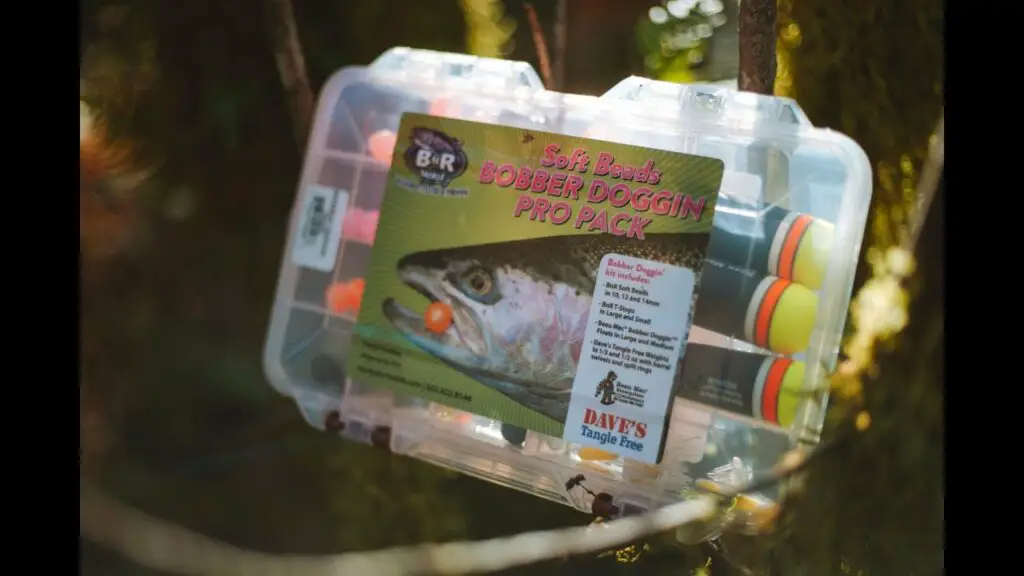
Bobber fishing steelhead can be just another term for the float fishing method I mentioned above or it can refer to a method also known as Bobber Doggin.
Bobber fishing using the Bobber Doggin method used a different setup and drift than float fishing.
With Bobber Doggin, your weight drags and bounces along the bottom which keeps the bait in the strike zone and slows the bait down.
Boober Doggin is a relatively new method that works well in all types of current speeds and will work on East and West Coast rivers.
I discuss the methods in more detail, show you the setup, and give you my honest opinion on it. See my article Bobber Doggin For Steelhead, Salmon, and Trout: A Complete Guide.
Other steelhead fishing methods include:
Baits For Steelhead
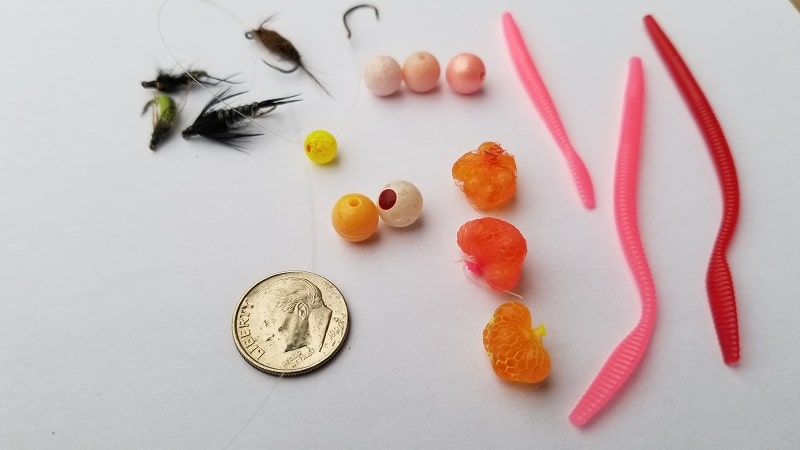
All of the above methods require the use of baits.
Baits can refer to anything you drift with or without a float or used when using still fishing methods like Plunking.
Natural Baits
These are baits that are organic, alive, dead, or something the wild steelhead actually eat. There are many that fit into this category and it is often believed by many steelhead anglers that natural baits are the best for steelhead.
Eggs For Steelhead Bait
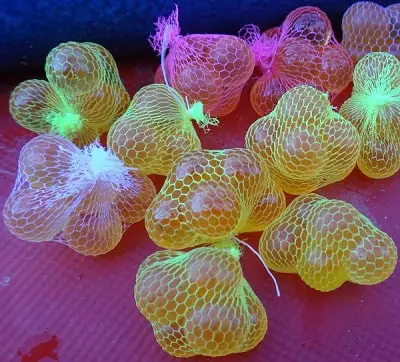
The most common bait for steelhead anglers anywhere you fish for steelhead are salmon eggs or trout eggs, which are also known as spawn, roe, spawn bags, skien, or egg sacs.
These are effective in most rivers and when cast into the ocean/lake from the shore.
Check out, Spawn Bags – Guide Secrets For More Trout And Steelhead
Trout and Steelhead Beads
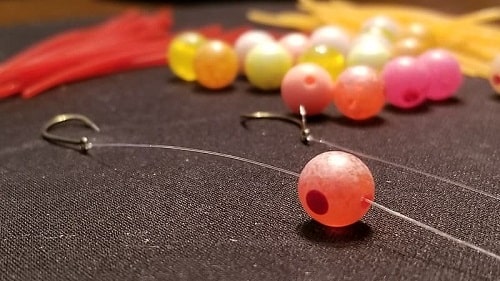
Soft and hard beads in multiple colors and sizes have been very effective anywhere you fish steelhead and steelhead anglers are catching on to this hot bait.
Soft plastic beads work but many anglers prefer the hard plastic, glass, or stone beads.
Check out these great articles:
Worms Are Great For Steelhead
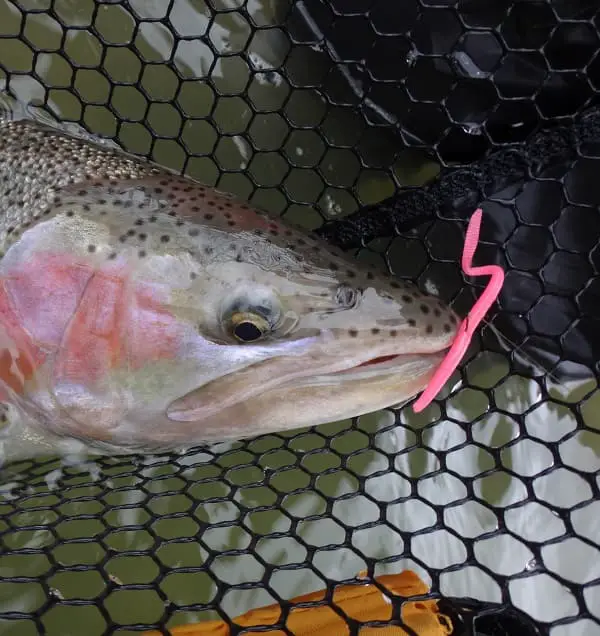
Rainbow trout, salmon, and steelhead all seem to love worms and most steelhead anglers will have some sort of worm bait with them.
Whether you use giant dew worms, live garden worms, or are like me and use the soft plastic steelhead worms in pink, red, and brown, worms can often be the most effective bait in all types of rivers.
Check Out Fishing With Worms For Trout and Steelhead: 10 Guide Tips.
Soft Plastics
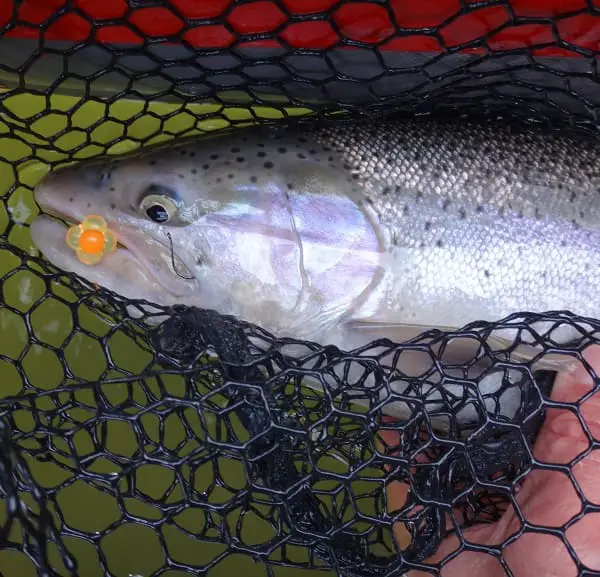
Soft plastics baits can include egg clusters, worms, grubs, or insects like nymphs and creature-type baits and they can all work at times and in different types of river conditions.
Flies For Steelhead
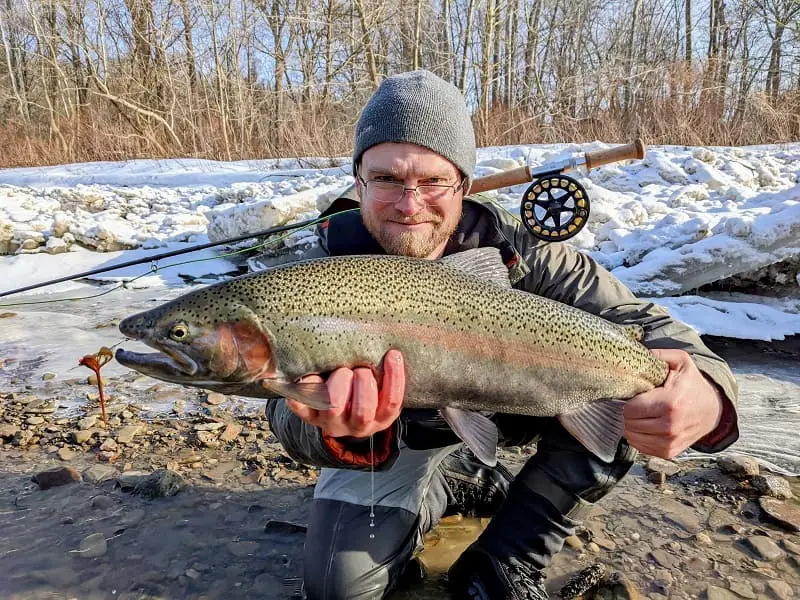
Artificial flies like those used by fly anglers can also be used with all the bait fishing techniques and it is highly recommended that anglers have some effective fly patterns with them when they are steelhead fishing.
Guide like Gareth and I tie most of our own patterns to match our rivers and the fish but there are many great flies you can get from your local fly shop.
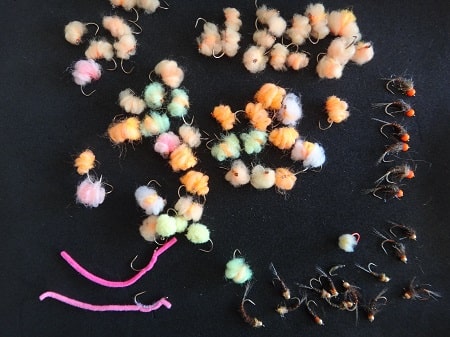
Fly fishing anglers know that flies like mayflies, stoneflies, and caddis larva nymphs can be very effective when other baits are not productive.
Fly anglers will also do very well on egg patterns, small streamer flies, large streamers, and spey flies.
Check out, 19 Best Flies For Steelhead: Most Effective Guide Flies
Other Effective Baits
I discuss the 11 best and most effective steelhead baits, how to set them up, and how to fish them with guide tips to make them even more effective for all steelhead anglers, and all on my page Best Baits for Steelhead.
Lure Fishing For Steelhead In Rivers
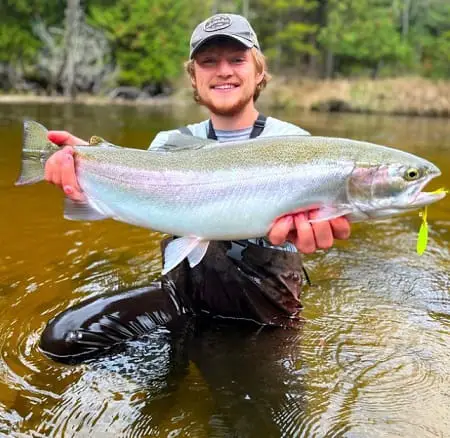
Lure fishing is a favorite and one of the most effective fishing techniques for steelhead.
Casting lures can be exciting and it can provide steelhead anglers the opportunity to have hard hits and multiple steelhead.
Feeding steelhead in the ocean and rivers will eat baitfish and lures do a great job of replicating baitfish.
Lure fishing can be done effectively from the river banks for migrating steelhead, from the shoreline of the lake or ocean, and from the pier of the river mouths.
Most lure fishing is done using a spinning rod and reel but a baitcasting reel will also work well.
Effective lures for steelhead include:
- Spinners – Spinners work in all types of waters, current speeds, and depths and are a favorite of many anglers and guides.
- Spoons – heavy casting spoons in the 3 to 4-inch size and in bright colors work best. Spoons are good from shore and in rivers.
- Crankbaits – Crankbaits like a Rapala with a deep or medium diving lip are often best for more steelhead rivers.
- Plugs – There are some lures known as plugs that are very effective especially in slower water or at certain times of the year. plugs like the Kwickfish and Flatfish are favorites of mine and other guides.
- Jigs – Not always considered a steelhead lure but jigs can be fished below a float or twitched and they can be very effective.
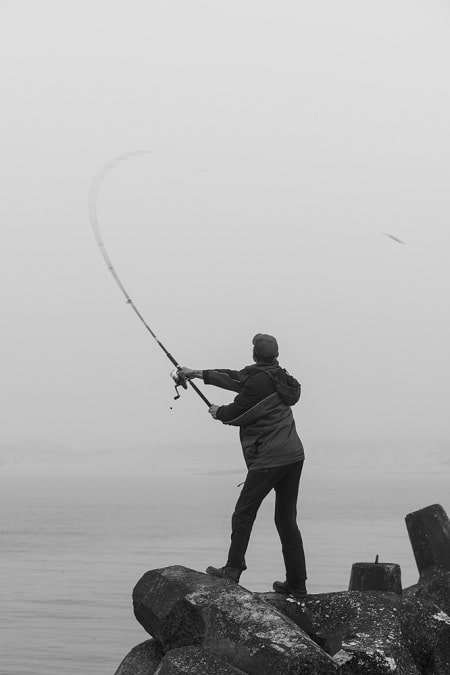
All lures will work on West Coast and great lakes steelhead and I discuss how to fish lures on my page Steelhead Lure Fishing Tactics and Guide Tips.
Also, check out 7 Best Lures For Steelhead – A Pro Guides Recommendations where I discuss the best lures and tips on how I use them to catch more steelhead.
Jig Fishing Steelhead: And Best Steelhead Jigs
Jigs can be used as a bait and drifted under a float or they can be cast out and jigged or twitched in to resemble baitfish that feeding steelhead love to eat.
More common with coho salmon anglers, the methods are exactly the same and equally effective.
Jigs will work with west coast and great lakes steelhead and I discuss the best jig fishing techniques, best steelhead jigs, best sizes, and best colors on my page Jig Fish Guide For Steelhead.
Ocean, And Lake Fishing For Steelhead
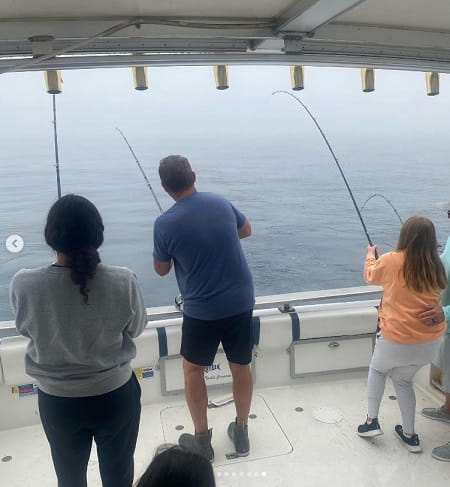
Although many areas will have steelhead in the river 12 months of the year, there are certain times of the year, primarily in the summer months, when most steelhead will be out in deep water feeding on baitfish.
Steelhead anglers will target steelhead in the lake and ocean from a boat. using specialized equipment and lures.
There are many charter boat services available if you don’t have your own boat.
Boat Fishing For Steelhead
Steelhead fishing by motorboat is a method that anglers use on bigger rivers and lakes and oceans. Boat fishing consists of three methods, Anchor fishing, Backtrolling, and Trolling
Trolling for Steelhead
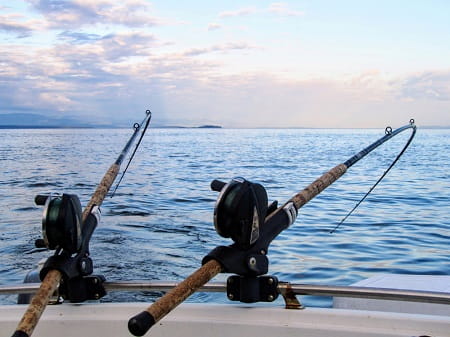
Lake Michigan, lake Ontario, and Lake Huron are three of the best lakes for trolling for steelhead and anywhere along the Pacific coast from northern California to Alaska can be good for steelhead trolling.
Trolling is the primary method for catching steelhead in the Ocean or the great lakes. Most steelhead anglers trolling will use Sonar or Fish Finders to locate steelhead of the schools of bait the steelhead feed on and then use Downriggers or Dipsy Divers to get their lures down to that depth.
Spoons, crankbaits, and plugs are go-to lures when trolling.
On very large rivers like the Niagara river, Columbia River, and Skeena river where the river is very wide and big, almost like a lake it is possible to troll for steelhead, however, there are other methods of boat fishing used by anglers to consider.
I will cover motorboat fishing methods for steelhead that are used out in the lake and in the bigger rivers in a future article.
Back Trolling For Steelhead
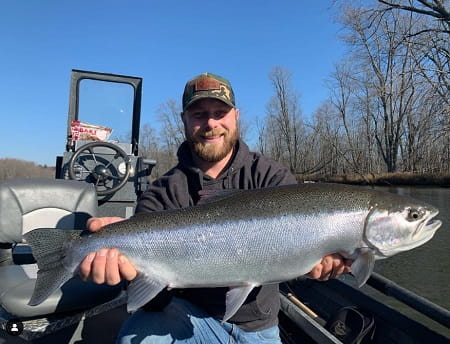
Back trolling for steelhead is when you let your lures out the back of a boat far enough that they get 3 to 5 feet off the river bottom and then you allow the boat to slowly drift backwards down the river, with the hope that you drop your lures in front of feeding steelhead.
This is often done with motor boats, or with a trolling motor and is often best done in deeper water over 5 feet deep.
Anglers can do this using inflatable pontoon boats or rafts, or from drift boats by putting an anchor down and then either lifting and dropping the anchor to let the boat and lures drop back, or by using a lighter chain anchor that allows the boat to slowly creep along down the river.
I will have an article on this method coming soon.
Anchor Fishing For Steelhead
Anchor fishing for steelhead is often done on large steelhead rivers out of a motor boat. The idea of the method is to anchor the boat with the nose of the boat upriver and let lures drift back towards the steelhead.
Once the lures have achieved the proper depth which is often a few feet over the river bottom the lure is held in place and the angler simply waits for a migrating steelhead to grab it. Often, anchor fishing is best in deeper water of 6 feet or more.
Anchor fishing can be dangerous in swift currents and should only be done by experienced anglers. The danger involves the possibility of the anchor rope wrapping around the prop and spinning the boat so the motor is upriver which can cause the back of the boat to be pulled under the water.
Steelhead Drift Fishing
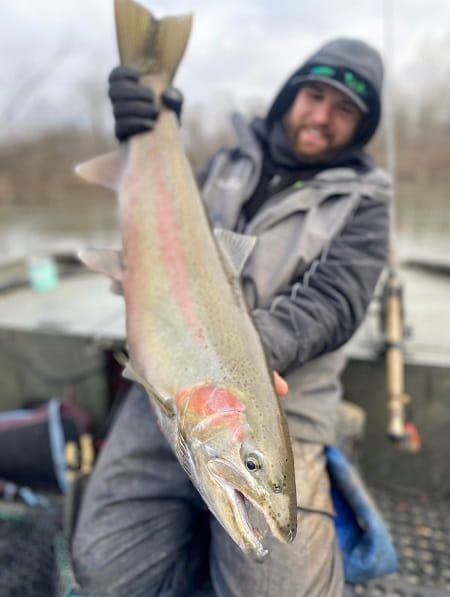
Steelhead drift fishing from a boat is a very effective and common method used by anglers, and it can be done on medium to very large rivers and can be done from most sized boats.
You can also do this from inexpensive pontoon boats and inflatable rafts like the ones I mention below.
Drift fishing generally starts with the angler positioning the boat upriver of a section of river and then slowly drifting the boat downriver and past the fish while presenting a bait, or while casting lures.
The traditional method is using a weight and bait lowered over the side of the boat. The bait is kept 2 to 4 feet off the bottom and the weight ticks along the bottom as the boat and rig drift down the river.
Guide Tip: Catch More Steelhead
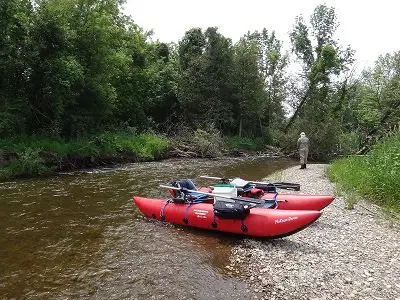
This is my 2 man boat that I use to guide from and I can get into rivers less than 20 feet wide and in shallower water of only 8 inches deep.
Single-man boats can be a great way for the average angler to get to uncrowded water and can be light and small enough to carry out in a backpack.
Steelhead fishing along many rivers can mean crowds, and many anglers fishing in the same area can make the steelhead go lockjaw and stop eating, but a boat gets you away from the crowds and into more steelhead.
I use 1 to 3-man pontoon-style boats that range from under 30 pounds to about 130 pounds, which enable me to get far away from the crowd or get me into sections of the river that flow through private property where nobody else can fish.
You can do this easily and cheaply and I will tell you how.
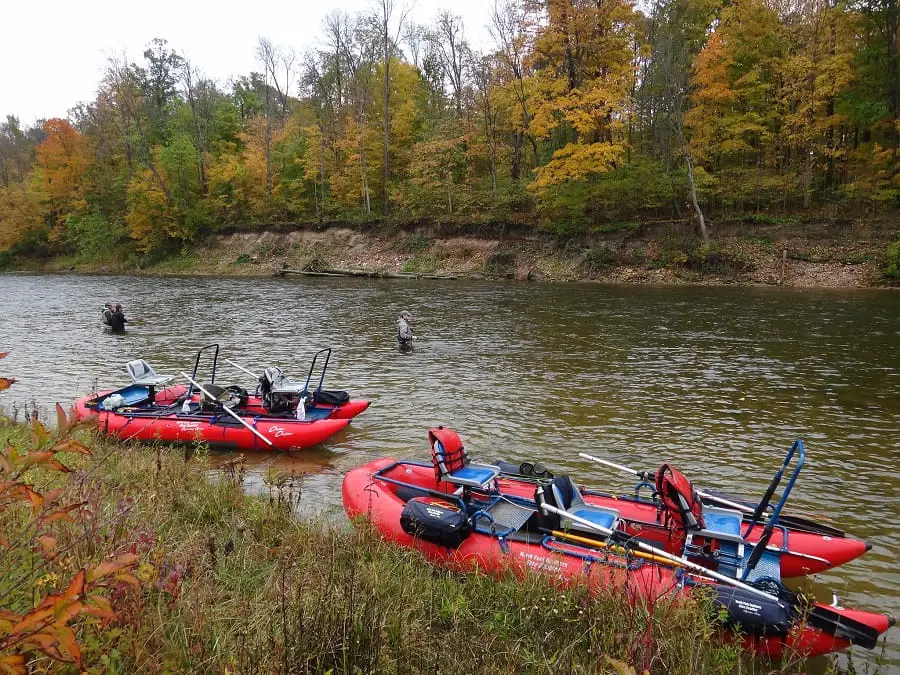
Some years I will spend 100 days on the water during the fall months and only see about 10 anglers in the sections where we fish, while other areas will be shoulder-to-shoulder crowded.
Using a riverboat like an inflatable pontoon has been the reason why many of my clients will experience 10 to 30 steelhead a day when other anglers in the public sections are only catching one or two.
To see how I do this and all the ways to do it easily with 1 or 2 anglers and to see the best boats for this, check out my page on River Boats For More Fish.
Shore Fishing And Pier Fishing For Steelhead
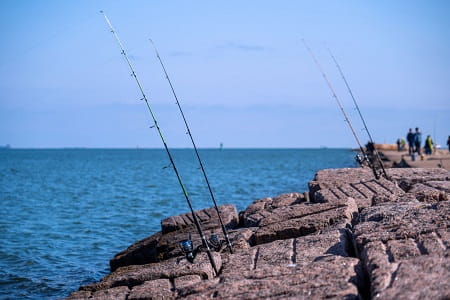
It’s not uncommon to see the shorelines near rivers lined with anglers waiting for cruising trout and salmon.
Pier fishing is popular with anglers because this is where you have the opportunity to catch large fish that are full of energy and are at their strongest.
Lure and bait fishing are the prominent methods when shore and pier fishing.
I will cover pier and shore fishing methods in another article so check back soon.
Steelhead that have not been fighting the current for miles will often fight harder and longer because they have more energy which is why many anglers will gravitate to the lower sections of rivers and to the piers.
Steelhead Fishing By Area: West To East
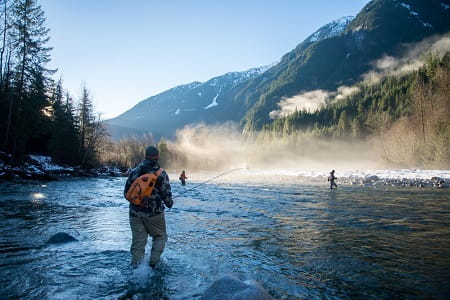
Steelheads are found naturally along the west coast of North America and the steelhead in this area tend to run around the same time of year depending if they are winter run steelhead or summer run steelhead.
Steelhead were also successfully stocked and have naturalized in the Great Lakes and migrating steelhead tend to run the rivers around the same times.
Naturalized means they are reproducing naturally and in many cases, they are flourishing.
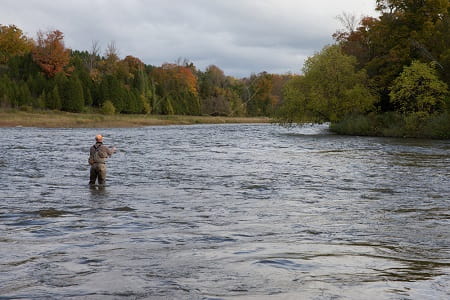
If you want to target steelhead, I have found that the methods, the baits, and the gear used on the West Coast can be slightly different than they are in the great lakes region.
Although the differences are often minor, and popular methods used on the west coast can still work on the great lakes, and vice-versa, once a popular method is established it’s a hard habit to break.
I have tested west coast methods on great lakes steelhead with success and then tested great lakes methods on west coast steelhead with success.
Steelhead Fishing Tackle: By Area And By Method
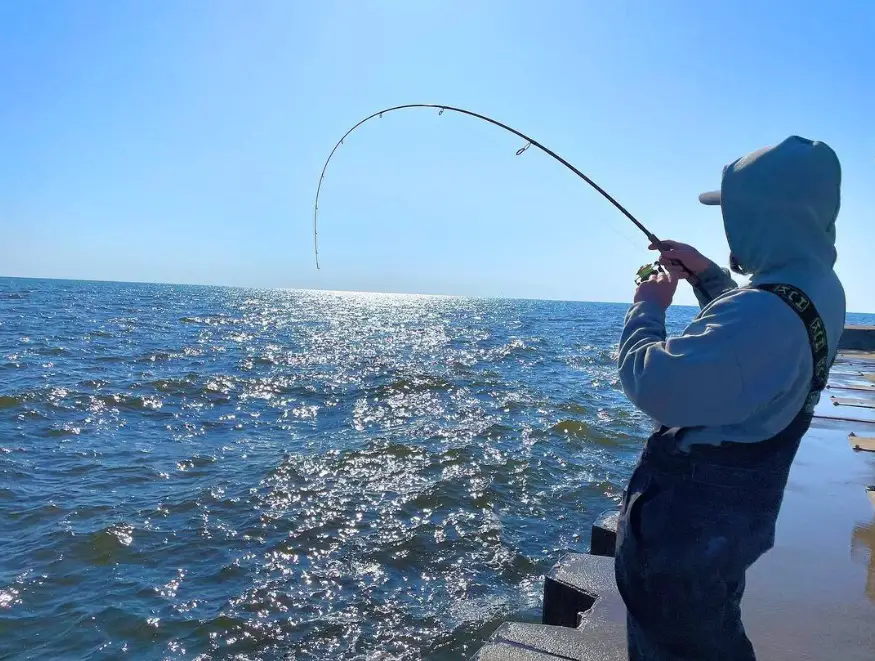
When it comes to these oversized rainbow trout, steelhead anglers will need to upsize their gear and tackle but be careful not to go too big and too heavy, and to match your tackle to the size of the river and the size of the steelhead.
As an example, an angler fishing small Pennsylvania streams for steelhead that average 3 to 5 pounds won’t require as heavy of a rod, leader, or a hook as an angler on a large west coast river would.
The rod, reel, and line size will depend on the river size and the fish. An average steelhead on a BC river might be 8 to 12 pounds and they will pull a lot harder in the bigger faster currents compared to the 30 foot wide trout streams in Western New york.
In general, large West Coast rivers require a heavier spinning rod and reel or a float or fly rod that’s suitable for the big water, as well as bigger lines, and bigger hooks. Bigger lines and leader are most important.
As an example, I will use 8-pound leader on a great lakes river and rarely break fish off, and I won’t need a super heavy rod because the leader is not that strong.
However, a fast-flowing big west coast river will require a 10 to 14-pound leader and a heavier rod that can handle the heavier leader and stronger fish.
On the smaller great lakes rivers that average from 20 wide to 60 wide, I use lighter tackle because once the steelhead is hooked, I can walk up or down the river easier and fight the fish more gently. I also find on the slower clear creeks and streams lighter leaders are required just to get them to bite.
Check out:
- What Pound Test Leader Is Best For Steelhead?
- 5 Most Effective Float Fishing Leader Setups Used By Pro River Guides
- 5 Best Rigs For Steelhead
The bigger west coast rivers usually require that you upsize everything by One or Two sizes.
For this reason, I have articles for each state and province where steelhead are found and I discuss proper gear.
The steelhead gear such as the rod and reel will also depend on the method use. When float fishing many anglers will use rod between 11 and 14 feet long. When casting lures, many anglers prefer rods from 7’6 to 9’6″.
Steelhead Gear:
- Rod
- Reel
- Line
- Fluorocarbon leader
- Waders
- Vest or a pack
- Wading net
- Forceps
- Knippers
See my article River Fishing Gear: Everything You Need To Succeed In 2023 for all the gear I recommend and use
Where To Catch Steelhead
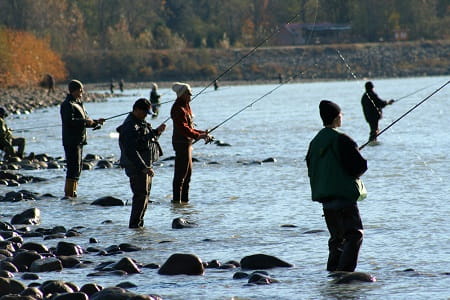
If you are considering planning a steelhead trip, or you live in an area that has steelhead, do as much research as possible, learn the most effective methods, time the runs well so you can be on the river at the best times, and then you will do well.
We’re here to help which is why we have location articles for all the areas you can fish for steelhead.
Check out the steelhead information for your areas.
- California Steelhead Fishing – Northern California has good opportunities for wild and stocked steelhead with decent public access on many rivers.
- Oregon Steelhead Fishing – Oregon has plenty of wild and hatchery steelhead rivers with both summer and winter steelhead and good access. Not to mention fantastic scenery and some f the best steelhead rivers in the world.
- Idaho Steelhead Fishing – Idaho steelhead fishing on famous rivers like the Salmon River and the Snake River can be fantastic.
- Washington Steelhead Fishing – Washington has some great steelhead riverd and some excellent steelhead and salmon fishing.
- British Columbia Steelhead Fishing – Arguallble the best summer steelhead fishing rivers in the world, with plenty of large and small rivers with both summer and winter steelhead and plenty of public access.
- Alaska Steelhead Fishing – Get here early since steelhead run in Alaska earlier than other rivers due to the extremely cold temps.
- Wisconsin Steelhead Fishing – Coming Soon
- Ontario Steelhead Fishing – Ontario Canada has more shoreline and steelhead rivers than any of the great lakes states. With days over 30 steelhead its worth checking out.
- Indiana Steelhead Fishing – Coming Soon
- Michigan Steelhead Fishing – Lake Michigan and Michigan tributaries might be considered the best steelhead fishing in the east with lots of steelhead, tons of public access, combined with many fish species like chinook, coho, lake run browns, and Skamania.
- Ohio Steelhead Fishing – A great stocking program in Ohio allows anglers the opportunity to have days of over 50 steelhead with many in the 3 to 6-pound range.
- Pennsylvania Steelhead Fishing – Similar to Ohio, Pennsylvania has many small rivers that get a huge annual run of steelhead that concentrate the fish so much that days of over 30 steelhead are possible,
- New York Steelhead Fishing – Some famous steelhead rivers like the Niagara river and the Salmon river are found in the state of New York. many other rivers in the area also get a big annual run of steelhead combined with salmon, and giant lake run brown trout.
These are all the areas with good steelhead fishing.
Steelhead Fishing License, Tags, Permits, and Regulations
Because of the wide distribution of steelhead, it is best to check the local regulation and even specific river regulations or restrictions before you fish.
As far as I know, all areas require a fishing license to fish for steelhead, and in some areas, a steelhead or trout tag, or other permits are required.
Even bait regulations like the banning of salmon eggs or multiple hooks could be in place.
Steelhead Guides: Steelhead Charter Services
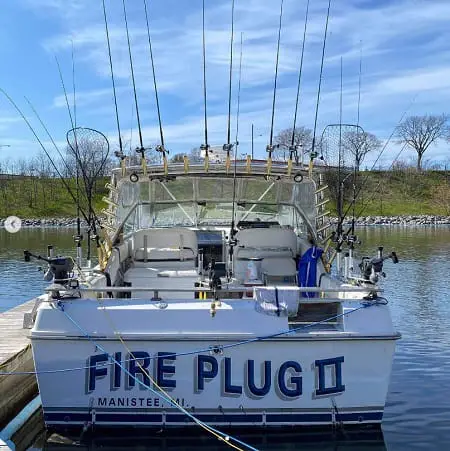
River guides catch a lot more steelhead than other anglers when steelhead fishing due to their understanding of the steelhead, and the methods that are most effective.
Hiring a steelhead guide is a great way to fast track learning how to catch steelhead. Nothing beats having a local guide, with local knowledge coaching you and telling you everything you need to know about how to catch steelhead.
Check out our guide page or do a quick search for local river guides in your area.
Steelhead Fishing: Commonly Asked Questions
There you have it, the four most effective methods for steelhead fishing that are used by most river guides. If you have a question or comment, or a tip for the readers or myself, or anything about steelhead fishing, just add it in the comment section below.
Tight Lines
Graham
